Smear Test Report 2025: Why are we avoiding
cervical screenings?
In the UK, smear tests are offered to all women to ensure they have had their first test by their 25th birthday. However, from common misconceptions to a general fear of what is considered an intimate screening, many women avoid going to or even arranging these appointments.
A cervical screening test, commonly called a smear test or pap test, is a procedure that checks for the human papillomavirus (HPV), which can cause abnormal cell changes in the cervix. Regularly checking the cervix for any abnormalities or inflammations is one of the best ways to protect yourself from cervical cancer.
Health insurance provider AXA Health has commissioned a survey to help educate and encourage women to attend these all-important screenings in the future. The survey looks at the most common women’s health misconceptions and top reasons for avoiding smear tests in the UK, across 2,000 females. It also looks at the generations and UK cities most likely to avoid cervical screenings.
Our survey revealed that 78% of females of the relevant age have attended a cervical screening. 16% have avoided a smear test altogether, with more Gen Zs (20%) avoiding appointments compared to 13% of Boomers and 0% of the Silent generation (born 1928-1945 ).
Key findings overview:
- Almost 1 in 10 (7%) have considered rescheduling or not attending a cervical health screening
- Nearly half (49%) of respondents said their biggest consideration is showering or washing before a screening test
- The most common reason for avoiding a smear test is being concerned about the procedure being uncomfortable or painful (46%)
- Over 1 in 3 (38%) believe you need a cervical screening every 4 years, yet it’s every 3 years
- Only 28% know that you can ask for a different-sized speculum
- Less than a third of women (30%) know what a colposcopy test is for
- Wales and Northern Ireland residents are most likely to avoid cervical health screenings
- 1 in 5 (20%) Gen Z’s have avoided a smear test
- The silent generation is the least likely to avoid a cervical test, with 0% responding that they’ve avoided a screening
Almost 5 million females in the UK have avoided a cervical screening appointment
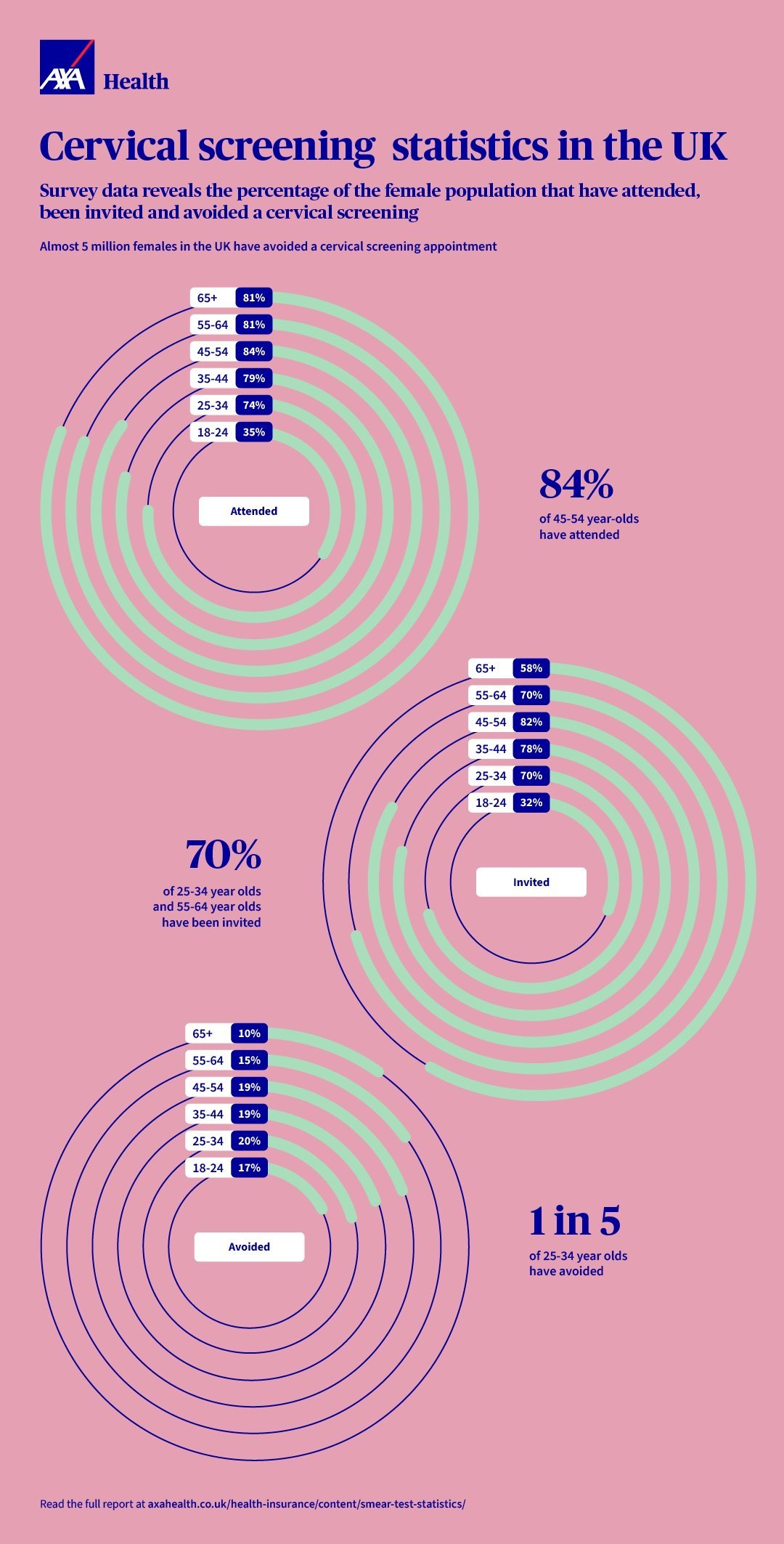
A smear test requires you to undress from the waist down, and the nurse will ask you to lie back on a bed, knees apart. They'll gently put a smooth, tube-shaped tool (a speculum) with lubricant into your vagina; this will be opened so they can see your cervix. Then, using a small soft brush, the nurse will take a tiny sample of cells from your cervix.
A cervical screening test should take less than five minutes, and the full appointment should last approximately 10 minutes.
However, our survey found that 16% of the total estimated female population has avoided a smear test. Women aged 45-54 were the most likely to attend their appointment (84%), whilst those aged 25-34 were the least likely (74%) with the highest avoidance rate at 20%.
Our data also found that out of the 78% who attended their cervical screenings, only 70% of these women were invited. This indicates that some females are keen to get a smear test despite having yet to receive their routine invitation.
35% of respondents aged 18-24 have also attended a smear test, which could be due to women taking the opportunity to have their smear as soon as they get the NHS letter when they’re 24.5 years old or when they’ve had an earlier test due to medical reasons.
Discover AXA Health insurance


Cost of health insurance
I'm interested in finding out more about health insurance costs.


Compare health insurance
I'm interested in getting more information to compare health insurance options.
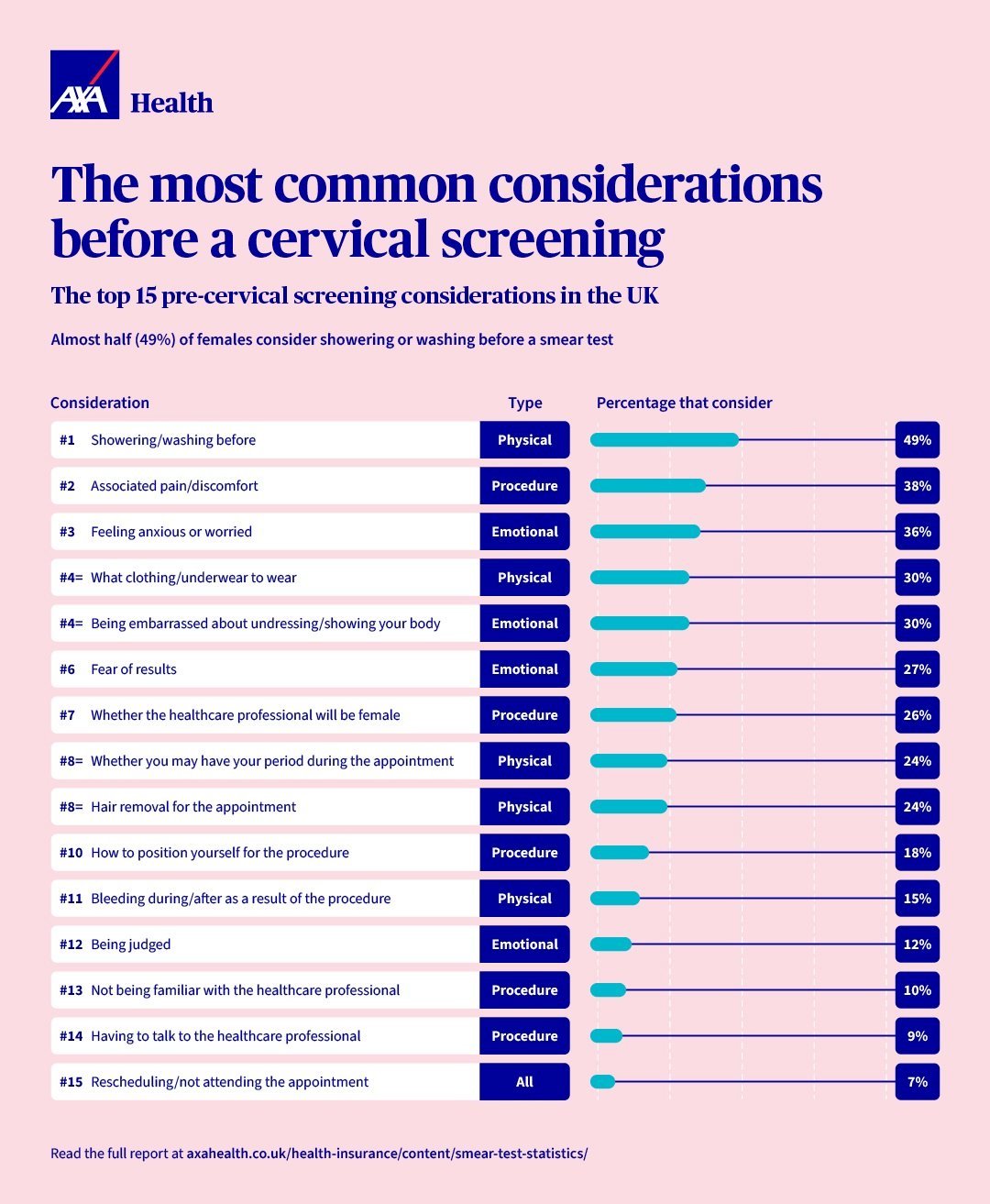
Once you get your invitation letter, which is approximately when you turn 24.5 years old, booking a smear test is the next step. However, a range of considerations could cause females to avoid booking and our survey has uncovered what these are.
Almost half of females consider personal hygiene before
a smear test
The most common consideration before a smear test was showering or washing, with 49% of women saying this is something they would contemplate. This was mostly prevalent amongst Gen X, with over half, 53%, of respondents in that demographic group identifying hygiene as a consideration.
Other common physical considerations were what to wear (30%), if they would be on their period (24%), hair removal before the appointment (24%), and bleeding during or after the screening (15%). However, it’s important to remember that your healthcare professional will have seen it all before, and you can always rearrange if you’re on your period.
For more information on the dos and don’ts before a smear test, check out our useful guide here.
Many people think about the actual cervical screening procedure itself
Regarding the procedure itself, the most common consideration was the associated pain or discomfort during the screening (38%). However, whilst the procedure may feel uncomfortable, it should be painless if you’re relaxed. Others also considered whether the healthcare professional would be female (26%), which you can ask for when booking your appointment,
This was followed by the positioning for the procedure (18%), unfamiliarity with the healthcare professional conducting the smear test (10%) and having to talk to the healthcare professional (9%) as the highest concerns for the women surveyed.
Emotions are tied closely to thinking about a smear test
A range of emotional factors, such as feeling anxious or worried (36%), being embarrassed about undressing (30%), fear of results (27%) and being judged (12%), surround a cervical screening test.
However, it’s important to remember that these are routine appointments that medical professionals carry out regularly, and the procedure is over in as little as five minutes. Gen Z were the most likely to feel anxious or worried (49%) about attending a cervical health screening, which could explain why this was also one of the highest demographics to avoid their appointment altogether.
Not many females have considered doing these things before a cervical screening
Only 5% of respondents considered bringing someone to their appointment, and only 3% considered listening to music during the procedure. Bringing along a friend, family member or chaperone to your appointment is allowed and recommended if it would help you feel more comfortable. Listening to music, particularly that of a slower beats per minute (BPM), can also ease feelings of anxiety and help you feel calmer.
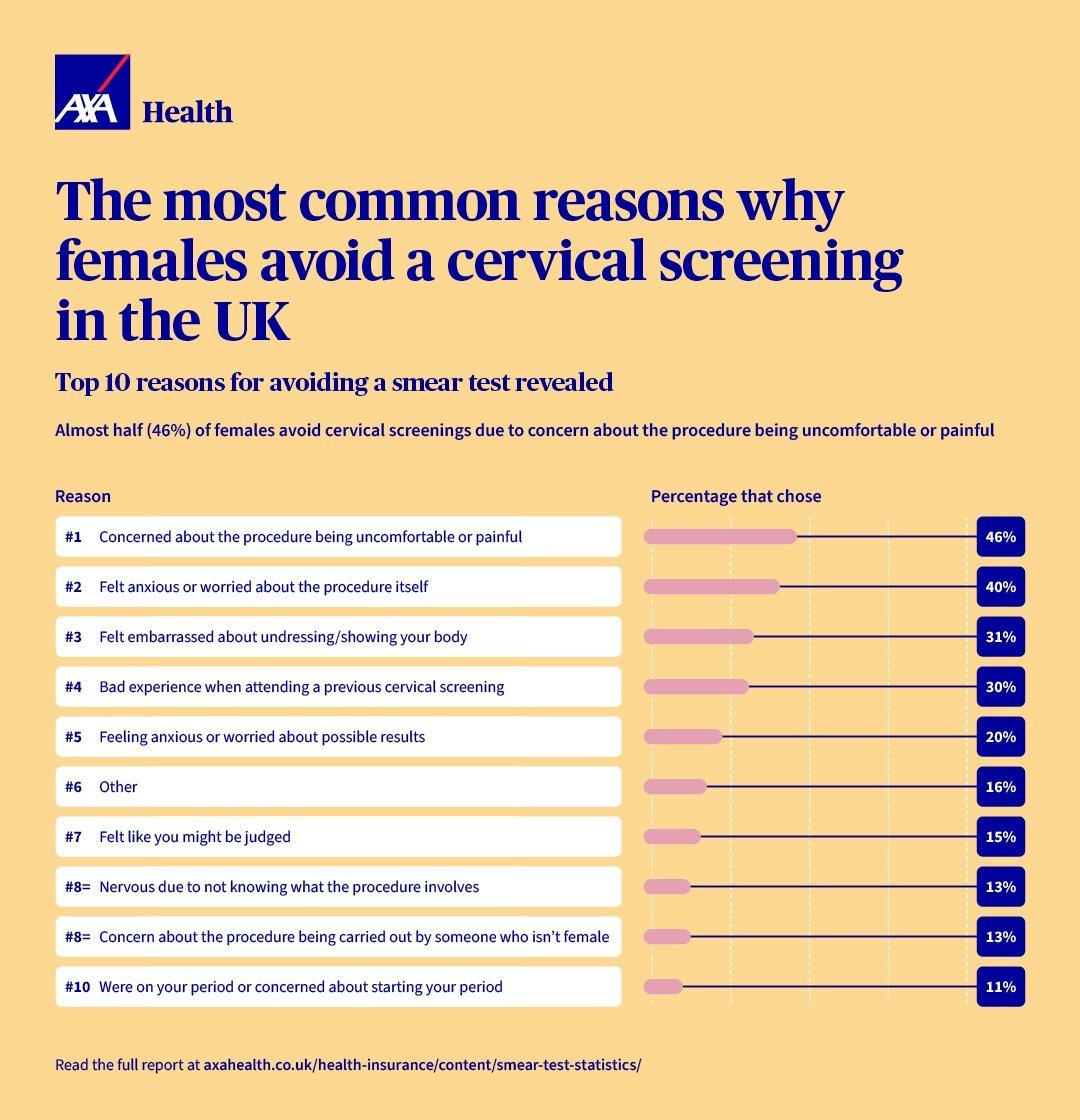
Almost half of females avoid cervical screenings due to concern about the procedure being
uncomfortable or painful
The most common reason for avoiding a smear test was due to concerns about the procedure being uncomfortable or painful (46%). However, a soft brush is used, and the nurse will be gentle to minimise any discomfort. Remember, you can stop the procedure at any time if you are in pain.
1 in 4 females feel anxious or worried about the
cervical screening procedure
40% of women responded to say they felt anxious or worried about the cervical screening procedure, which would lead them to avoid their smear test. Our survey found that women are twice as likely to worry more about the actual procedure than the results (20%).
For the majority of women, a cervical screening test is likely their first medical appointment regarding their vagina, so it is natural for a degree of worry regarding the unknown. However, this routine and super quick procedure is vital in preventing cervical cancer; if you’re worried, bring along a trusted friend or family member for support.
Over 30% have avoided a cervical screening due to embarrassment about undressing
or showing their body
Almost one-third of respondents say they have avoided a smear test due to embarrassment about undressing or showing their body (31%). While it is understandable to feel a degree of discomfort exposing an intimate area, you will be provided with a sheet to put over you, and you can undress behind a screen.
Almost 1 in 3 have avoided a screening test due to a previous bad experience
30% of women have avoided attending a subsequent screening due to a previous bad experience. If you have ever had a negative experience during an appointment, you should always report this to your GP practice to prevent this from happening again in the future.
Discussing with your practice will provide reassurance and you can ensure to be seen by a different professional for your next appointment.
1 in 10 have avoided a smear test due to concerns about their menstrual cycle
11% of respondents avoided their cervical screening as they were either on their period or concerned about starting their period. If your smear test falls during your period, you should contact your healthcare provider and rearrange the appointment rather than avoid it completely.
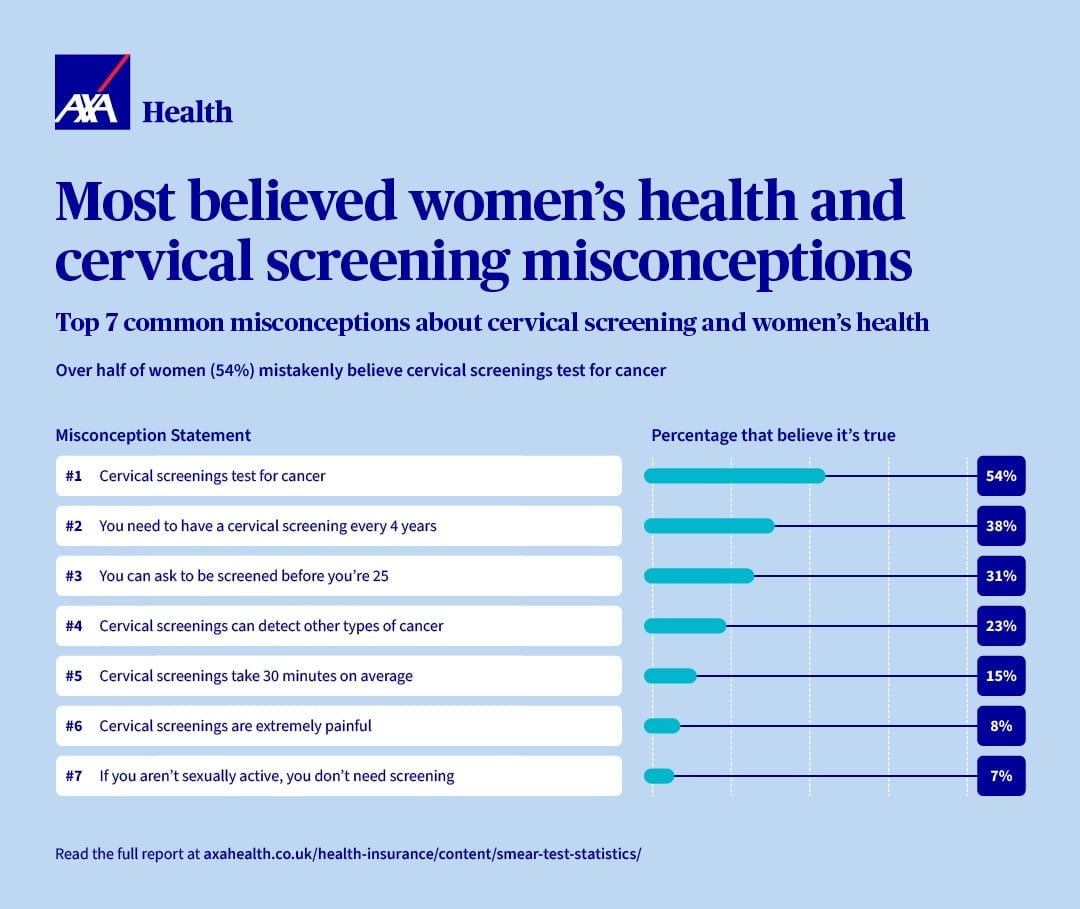
Cervical screenings test for cancer, and can detect other
types of cancer - BOTH FALSE
Over half of women (54%) think cervical screenings test for cancer, when in fact, a smear test does not test for cervical cancer, or any type of cancer, but instead helps spot early signs of abnormalities. 23% of women think cervical screenings can detect other types of cancer, which is false. The small sample of cells taken from your cervix are checked for “high-risk” types of human papillomavirus (HPV) that can cause changes to the cells of your cervix. If these types of HPV are found, they can be treated before they get a chance to turn into cervical cancer.
You can ask to be screened before you’re 25 - FALSE
For a smear test, you need to receive an invitation letter, which is currently 6 months before you’re 25th birthday. Although smear tests are offered to everyone with a cervix upon turning 24.5, almost 4 in 10 women incorrectly believe you can ask for one earlier.
However, it is possible to book a private smear test. Private health providers may offer appointments outside standard NHS guidelines, such as for individuals who want screening more frequently. Also, even though routine cervical screening doesn’t start until after 25, it’s important to see your GP if you experience any unusual symptoms at any age. Symptoms like irregular bleeding, unusual discharge, or pain during sex could indicate an issue that needs further investigation.
If you’re wondering at what age you should book your smear test, check out our guide here.
Cervical screenings are extremely painful - FALSE
A smear test should not be painful, but it may feel a little uncomfortable, which can vary from person to person. However, almost 1 in 10 of respondents (8%) believe the misconception that cervical screenings are extremely painful, which is not the case and contributes to why many people with cervixes avoid their appointments.
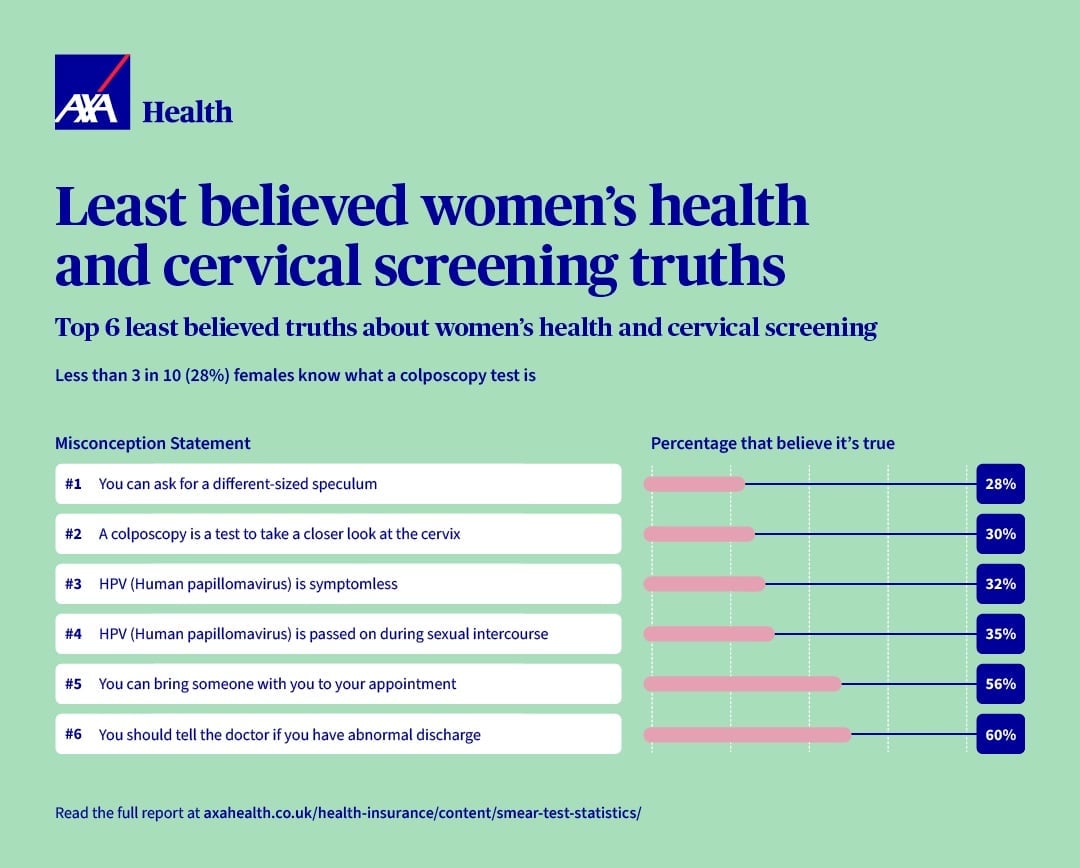
You can ask for a different-sized speculum - TRUE
Despite only 28% of respondents believing this to be a misconception, you can in fact ask for a different-sized speculum. If you experience pain, communicating with your healthcare professional will prompt them to understand if you require a smaller speculum. Lubricant can also be provided to minimise discomfort and allow for easier insertion.
HPV is symptomless and is passed on during sexual
intercourse - TRUE
Only 1 in 3 women (32%) believe that HPV is symptomless. However, this is true and that’s why you need a cervical screening test to find out if you have it. Only 35% believe HPV is an STI, which is also true.
HPV is transmitted through skin-to-skin contact and not through blood or body fluids, but it is still classed as an STI. HPV differs from other STIs as it can remain in the body for weeks, years, or even a lifetime. It’s possible to have HPV for many years without it causing problems.
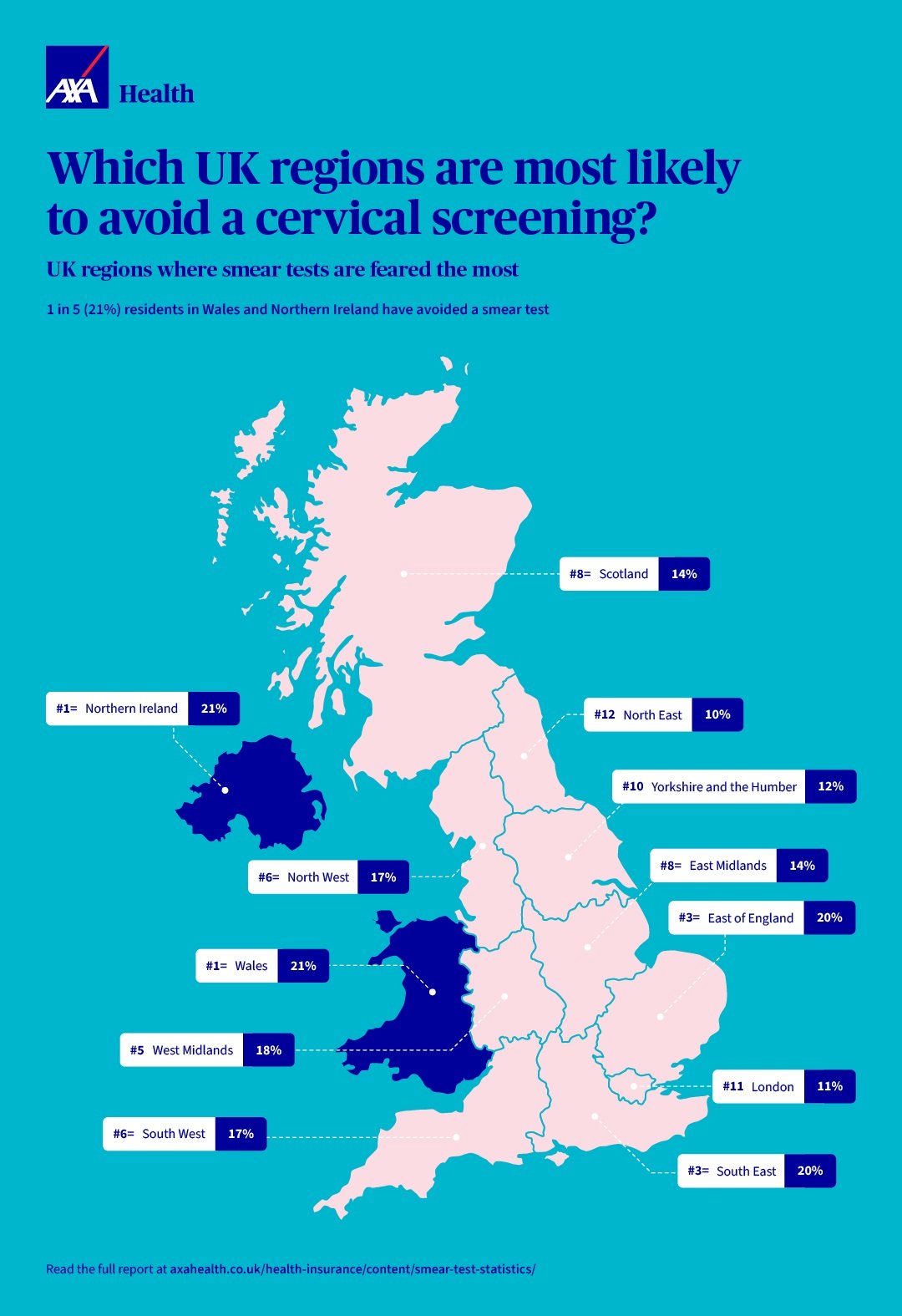
Residents in Wales and Northern Ireland are most likely to avoid
a smear test
People in Wales and Northern Ireland were found to avoid cervical screenings the most at 21%, which is over 1 in 5 respondents. Swansea (44%) and Wrexham (24%) were the two Welsh cities most likely to avoid their cervical screening, with Wolverhampton (26%) and Plymouth (22%) being cities avoiding smear tests the most in England.
In 2022, Wales changed the time between smear tests for those eligible aged between 25 and 49. Residents are now screened every five years compared to three, so a lower frequency and therefore less familiarity with the test may be why they are more hesitant about attending their appointment. Also, in Northern Ireland, there is a review of cervical screening tests dating back to 2008, with many tests being re-checked, which may have led to people being less forthcoming when attending their appointments.
Females in London and the North East are most likely to attend
their smear test
London (11%) and the North East (10%) had the lowest percentages of people avoiding their smear tests. 77% of residents in Newcastle went to their cervical screenings, which was one of the highest attendance rates across all the UK cities. This could be due to a factor of reasons including barriers to attending being different in these regions, such as accessibility, better booking systems and education.
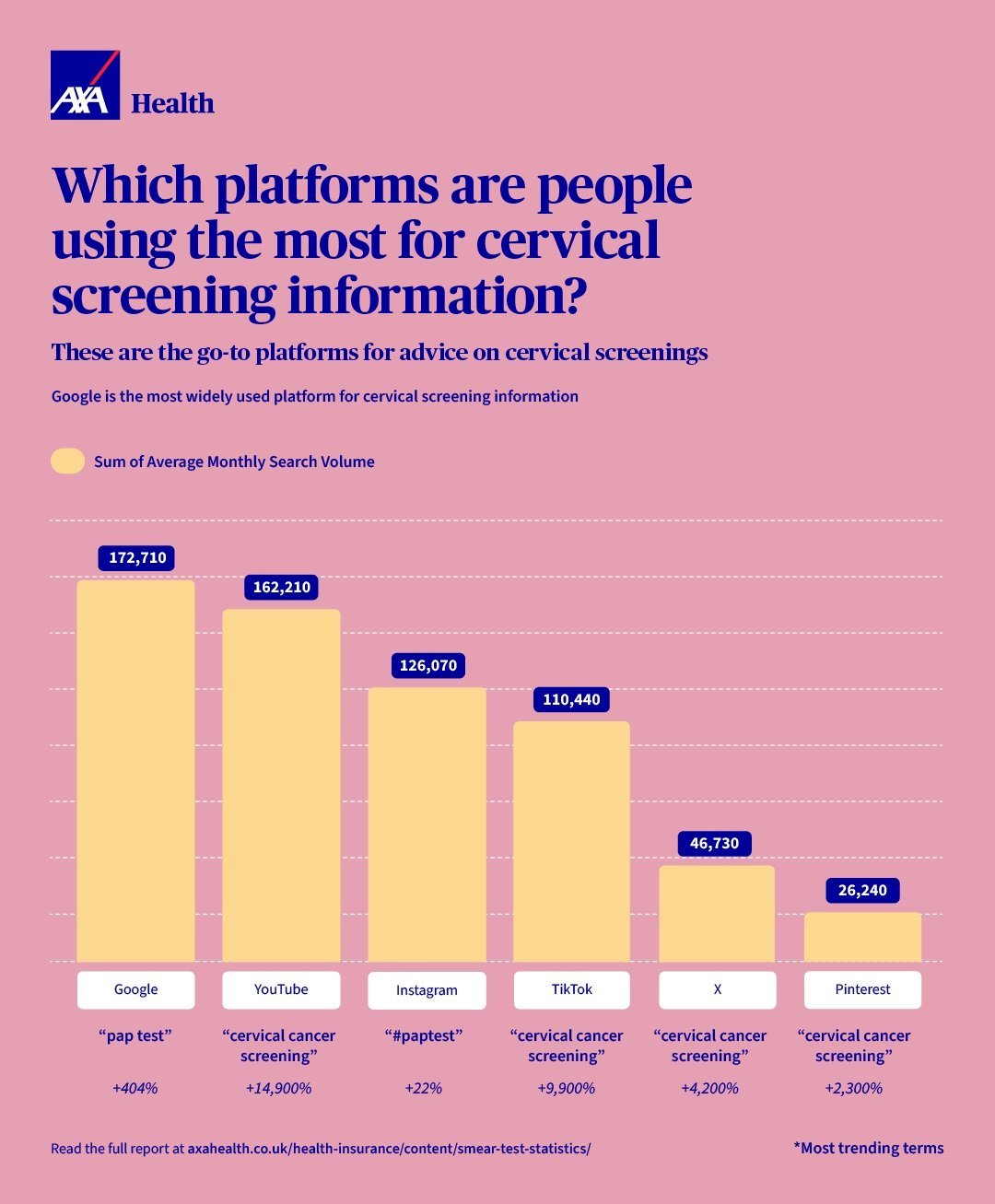
Google was the most widely used platform amongst women to search for information around cervical screenings, with the highest trending term being ‘pap test’ and an average monthly search volume of over 172,000 related terms.
The go-to social media platform is YouTube, which had the biggest search increase over the past year at 14,900% and only 10k fewer monthly searches than Google.
People are ready to try at-home smear tests
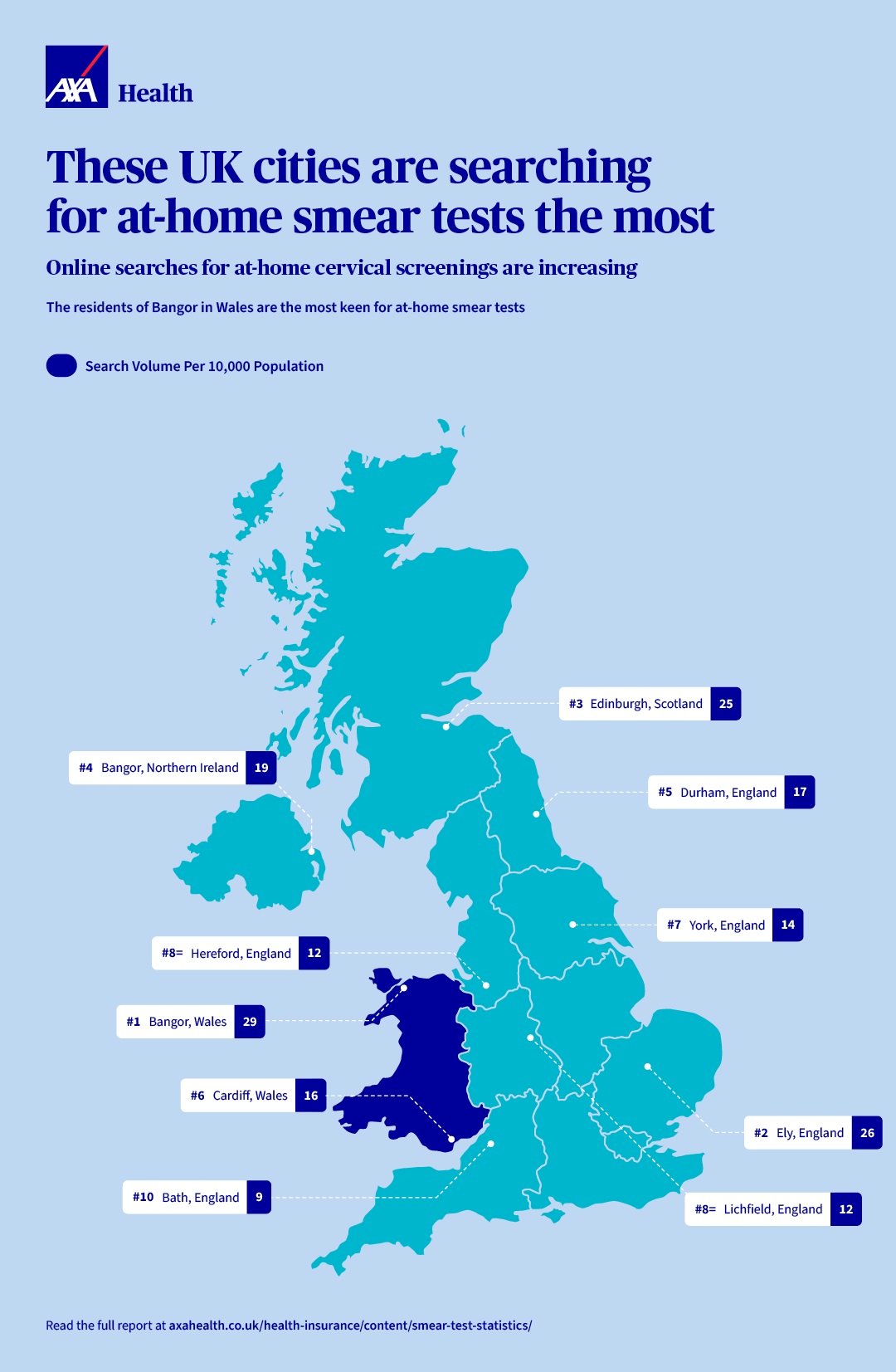
Online searches for at-home cervical screenings
are increasing
As our survey found that the most common reasons for avoiding or being concerned about attending a smear test were embarrassment around undressing and hygiene, it’s perhaps unsurprising that online searches for at-home smear tests are increasing. Although they’re not available yet, recent trials to increase testing through at-home test kits have been very successful.
Bangor, Ely, and Edinburgh are currently the top three UK cities searching for at-home tests online.
Reviewed by Dr Pallavi Bradshaw

Dr Pallavi Bradshaw is Deputy Chief Medical Officer at AXA Health, with over 20 years of experience in global healthcare. Pallavi graduated from St Catharine’s College, Cambridge and trained at Addenbrooke’s Hospital as an Ophthalmologist before joining the Medical Protection Society (MPS). In her role she provides support and leadership across AXA Health, guiding the development of AXA Health’s external policy, with a particular interest in patient safety.
Methodology
AXA Health surveyed 2,000 UK nationally representative females aged 18+ in December 2024. Survey questions included if respondents had been invited, attended or avoided a cervical screening, factors to consider before attending an appointment, belief in a range of cervical screening statements and reasons behind why those who avoided a cervical screening did so.
Sources
- Smear test ages - GOV.UK
- UK Female Population - ONS - 31,019,000
- Search Volume - KeywordTool.io
- Slow tempo music diminishing stress - Harvard Health
- HPV - NHS
- UK cities - GOV.UK
- City-Specific Population - World Population Review
- Smear test at-home screening - The Guardian

